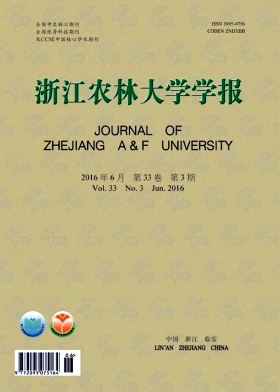-
据估计,到21世纪末,由于大气中的温室气体,特别是二氧化碳(CO2)浓度的增加,全球平均温度预计将增加2~7 ℃[1]。随着人们对气候变化和温室气体减排的越加重视,关于农田土壤固碳潜力的研究也日趋深入。而土壤作为一个巨大而且具有挥发性的潜在碳库,可以缓冲大气中二氧化碳浓度的增加。土壤碳库的微小变化,都可以引起大气二氧化碳浓度的显著变化[2]。例如,ESWARAN等[3]的研究显示,全球土壤有机碳储量0.1%的变化将导致大气中二氧化碳质量浓度10 mg·L-1的变化。而据推测,在2 m土层中的土壤有机质浓度增加5.0%~15.0%可使大气中的二氧化碳浓度减少16%~30%[4-5]。可见土壤碳库的稳定、增长或衰减都与大气二氧化碳浓度变化密切相关。此外,土壤有机碳库约占陆地总有机碳库的2/3,是大气碳库的2倍。土壤平均每年排放到大气中的二氧化碳约为化石燃料碳排放量的11倍,大气二氧化碳储量的10.0%[6]。由此可知:土壤碳库积累和变化直接影响全球的碳平衡,也是大气碳库和全球气候变化的主要原因[7],因此,土壤在稳定全球气候、减缓温室效应方面发挥着重要作用。在陆地生态系统中,碳汇功能体现在碳库的储量和积累率,而碳源则体现在碳的排放强度。土壤碳库的变化主要表现在土壤有机碳储量的变化上,土壤有机碳储量是进入土壤有机物质(生物残体等)的输入与损失(以土壤微生物分解作用为主)之间的平衡[8],而土壤有机碳的稳定性则主要体现在土壤有机碳周转期的长短。鉴于此,土壤中碳库的量化和稳定性机制引起了科学家的极大关注[9-10]。然而,在预测21世纪大气二氧化碳浓度时,土壤有机碳的稳定性是其不确定性的主要来源[11]。而提高土壤有机碳的稳定性可以使土壤以有机物的形式固定大气中更多的二氧化碳,有助于科学客观地预测土壤有机碳的动态变化等,提高土壤的碳汇功能。土壤有机碳的一个重要组成部分就是植硅体封存有机碳(phytolith-occluded organic carbon,PhytOC,以下简称植硅体碳),植硅体碳是植硅体在形成过程中封存在部分植物细胞中的有机碳。植硅体存在于多种植物细胞中,是高等植物通过吸收单硅酸,在细胞内或细胞间硅化沉淀形成的非晶质二氧化硅矿物颗粒。植硅体碳具有强稳定性,可在土壤中长期保存,稳定达数千年至万年之久,成为陆地土壤长期固碳的重要机制之一。植硅体封存有机碳是土壤中重要的有机碳种类,且作为生态系统碳汇的重要组成部分,关于其稳定性的研究,比如如何准确测定和评价植硅体碳的稳定性,以及采取优化管理措施来提高植硅体碳的稳定性等已引起各国科学家的注意。本文综述了土壤植硅体封存有机碳的形成机制与特征、植硅体碳稳定性研究的重要意义以及影响植硅体碳稳定性的因素。
HTML
-
土壤有机碳的稳定性分为生物化学稳定性、化学稳定性和物理稳定性等。闭蓄在团聚体内和吸附矿物上的土壤有机碳(SOC)是物理保护机制[12]。
土壤团聚体分为大团聚体(>250 μm)和微团聚体(<250 μm)。2种团聚体的物理稳定性机制是不同的[12]。在有机质的实验分组方法中,物理分组方法最为普遍。物理分组方法包括颗粒大小分组(particle size fractionation)和相对密度分组(density fractionation)。前者根据有机碳与土壤中不同初级颗粒结合形成各级复合体将有机碳分成砂粒结合态有机碳(50~2 000 μm),粉粒结合态有机碳(2~50 μm)和黏粒结合态有机碳(<2 μm),而后者根据有机碳与土壤矿物结合的形态将有机碳简单分成轻组有机碳和重组有机碳[13-14]。
土壤颗粒态有机碳(particulate organic carbon,POC)是介于新鲜的动植物残体和腐殖化有机物之间的暂时或过渡的有机碳组分,是与砂粒结合的有机碳部分,在土壤中周转速度较快,比土壤总有机碳更易受土地利用方式的影响[15]。吸附矿物表面的有机碳,主要与不同粒级的矿物颗粒紧密结合,形成有机-无机复合体,使其矿化速率大为减慢,故这部分有机碳往往相对稳定[14]。
土壤中存在的安全碳的形态有物理性保护的有机无机复合体(如微团聚)、木炭和植硅体碳。植硅体碳的封存机制被认为是有机无机复合体抗化学溶解的物理保护作用[8],木炭的形成也可被认为是土壤碳的长期封存机制[16]。植硅体碳具有很高的抗氧化和抗分解能力,是最稳定而安全的碳的形态。可长期累积于土壤中达数千年至万年之久,因而成为陆地土壤长期固碳的重要机制之一[17-19]。
-
土壤有机碳稳定性可用平均滞留时间(MRT)或周转期来量化。土壤有机碳中碳元素的周转一般是由输入和输出之间的平衡所决定。土壤有机碳的周转率通常用碳稳定状态的平均滞留时间(MRT)或半衰期(T1/2)来表示。碳的平均滞留时间可定义为稳定状态下碳平均滞留时间,也可定义为稳定状态下元素完全更新的时间。土壤有机碳的半衰期为现有碳库分解一半所需要的时间。
区分土壤中稳定态土壤碳和不稳定碳对于探明土壤碳稳定性的机制至关重要。由于土地利用或管理等变化引起了环境条件的改变,矿质土壤总有机碳含量须经过几十到几百年才能平衡。土壤中生物、化学和物理过程之间复杂的相互作用使得不同土壤有机碳成分具有不同的化学结构和分解速率,周转时间从几小时到近万年[11, 20]。依据周转速率的快慢把土壤有机碳分成易变碳库(labile carbon pool)和稳定碳库(stable carbon pool),或活性库(active pool),慢性库(slow pool)和惰性库(passive pool)。CENTURY SOM模型[20]则把土壤碳划分为活性库(active pool),慢库(slow pool)和被动库(passive pool),其平均滞留时间值分别为1.5,25.0和1 000 a。表 1列出了具有不同土壤有机碳周转期的碳库类型及其化合物。
残留物类型 碳库类型 物质类型 平均滞留时间/a 碳氮比 化合物 凋落物 代谢 可分解的植物材料 0.1~0.5 10-25 单糖,氨基酸,淀粉 结构 — 24 100-200 多糖 土壤有机碳 活性碳库 微生物生物量 可分解的植物物质 1-2 —— 活的生物量,颗粒有机质,多糖 慢性碳库 抗性植物材料 15?100 10-25 木质化组织,蜡,多酚 被动碳库 腐殖化有机质 惰性有机质 500-5 000 7-10 腐殖物质,黏土,有机配合物,生物炭 植硅体碳 硅化有机碳 <200-13 300* — 糖类,蛋白质,类脂物 说明 *植硅体碳在土壤中的存留时间。
1.1. 土壤有机碳的稳定性的分类
1.2. 土壤有机碳稳定性的量化指标及周转时间
-
植硅体(phytolith)是高等植物根系吸收土壤中的可溶性单硅酸(H4SiO4),并在叶片的蒸腾作用下沉淀在植物细胞壁、细胞内腔和细胞壁间而形成的水合物(SiO2·nH2O)[17, 24]。这种硅化的过程,常将少量有机碳封存在植硅体中,这部分有机碳就被称为植硅体碳。土壤本身并不产生植硅体。植硅体主要是植物残体(主要以凋落物的形式)腐烂分解后释放到土壤表层,但并非植物产生的所有植硅体都可返回到土壤。
-
植硅体的化学成分主要是SiO2(67%~95%),水分(1%~12%),有机碳(0.1%~6.0%)及少量的无机元素铝(Al),钠(Na),钙(Ca),铁(Fe),钾(K)和钛(Ti)等[25]。植硅体有复杂的内部结构,大小约为2~2 000μm,但多集中在20~100μm。通常1 g禾本科Poaceae植物叶中含有10~100万个植硅体。植硅体中含有少量的结晶水,其密度为1.5~2.3 g·cm-3[26]。植硅体的结构式中含有很多羟基(—OH),这种配位基容易与其他元素结合[25]。植硅体中的有机碳主要成分为糖类、蛋白质和类脂物,没有DNA和木质素[25, 27]。植硅体还具有很强的抗腐蚀、抗分解、抗氧化等特性,因此,植硅体可以长时间的保存在土壤中[25, 28-29]。
-
通过凋落物的降解,植硅体被释放到土壤中并成为其中的矿物组成成分。有研究表明:在热带雨林中由枯枝落叶等释放到土壤中的植硅体有92.5%溶解后又被植物重新吸收,只有7.5%保存在林地土壤中,成为稳定硅库的一部分[30]。返回到土壤的植硅体由于生物扰动、迁移溶解、火灾、动物排便、地表径流、机械混合等方式的共同作用使其在土壤剖面中分布[31]。植硅体的大小大多为20~200 μm,因此,土表植硅体可以通过土壤空隙迁移到土壤下层[32]的研究发现,植硅体碳向深层土壤迁移的距离可达到2.2 m。对芦苇Phragmites communis植硅体在土壤中的运移模拟实验研究发现,沙质沉积物中植硅体通过低频和高频灌溉5个月后分别相应向下运移(2.7±1.6)mm和(3.7±0.2)mm[33]。
土壤中植硅体在土壤剖面中的分布主要取决于土壤剖面特征、土壤空隙的大小、土壤水分状况、植硅体与黏土颗粒的粘合强度及植硅体的溶解。植物枯枝落叶首先进入土壤表层,因此,表层中植硅体含量相对较高,并随着土壤深度的增加而减少[17, 34]。然而,FISHER等[35]则认为植硅体不易向下运移。例如,水耕人为土中植硅体主要分布于耕作层[36],因为紧密的犁底层的存在阻止了植硅体的向下移动。桂林市境内的碳酸盐岩土壤植硅体土壤剖面分布与水耕人为土基本一致,表土含丰富且形态多样的植硅体,20 cm以下植硅体含量极少或没有[37]。
森林植被碳储量虽然能直接反应森林生态系统的碳汇潜力,但是森林植物最初固定的CO2经过长期分解以后95%以上的将会返回到大气中,而剩下的由植硅体所封存的有机碳和其他形式的有机碳组成的有机残余物将转化长期的安全碳形式,并能长时间的保存在土壤中。因此,土壤植硅体碳占土壤总碳的比例将随着土壤年龄的增加而升高。
土壤PhytOC/TOC是土壤植硅体碳占土壤总有机碳的百分比,它是表征长期土壤有机碳封存机制的一个重要指标。总体而言,PhytOC/TOC比值都是随着土层深度的增加而增加,而且植硅体碳的稳定性也随着土层深度的增加而增加[17]。
2.1. 土壤植硅体碳的形成机制
2.2. 土壤植硅体碳的特性
2.3. 土壤植硅体碳稳定性在土壤剖面中的变化
-
形成植硅体时所封存的一些原有细胞质的有机质被称为植硅体碳,可长期保存土壤中而具碳固持潜力[17-19, 25, 38]。植硅体碳累积量估计占过去1 000 a内全球持留的碳的年土壤碳累积量(2.4 g · m-2 · a-1)的15%~37%[37]。根据碳同位素定年法,PARR等[17]发现古土壤中植硅体碳的年龄大约是8 000 a。而WILDING等[39]则对泥炭地沉积物的植硅体碳进行检测,发现其年龄可以达到距今1.33万a。这都说明了植硅体碳是一种非常稳定的碳汇机制,也是土壤碳库的重要组成部分。
大约50%~90%的土壤有机碳是由周转时间为10 a左右的活性碳所组成[40]。在土壤中可持留上百年至数千年长的有机碳是很少的,有人估计仅为初级生产固碳量的0.7%[37]。过去土壤中植硅体碳的作用一直未被肯定,最有可能是由于在土壤有机碳周转模型中广泛采用物理分离程序来确定各种土壤有机碳库。虽然这些方法在整合土壤有机碳的结构和功能特性方面具有明显的优势[41],但他们没有直接对植硅体碳库进行量化。鉴于植硅体碳在土壤可以积累一定数量,而且它因抗分解而显示其十分稳定,对许多土壤物质来说,它可能是大部分土壤有机碳周转模型中一个相当重要部分。
由于植硅体碳相对于储存在植被中的碳和土壤中的其他形式的碳来说更加稳定,因而能在土壤剖面中形成稳定的有机碳库[18, 32-33],并在较长年限内不会参与大气碳循环。因此,近年来,它作为一个重要的长期的陆地碳库,在调节全球碳循环和缓解全球气候变暖趋势等方面具有的重要作用已经引起科学家的极大关注[17-19, 25, 38]。最近研究表明:全球竹林会通过植硅体长期封存二氧化碳15.6×106 t·a-1。PARR等[18]研究认为:如果全球4.1×109 hm2的潜在耕地都选择种竹子,并按中等的植硅体碳封存速率(0.36 t·hm-2·a-1),全球植硅体碳封存量将达到1.5×109 t ·a-1(二氧化碳)。这将有效地减少全球二氧化碳排放量,可占当前增加大气二氧化碳排放量的11.0%。
植硅体碳对了解人类活动或气候变化所引起的碳素平衡也是至关重要的[42]。虽然植硅体碳仅占土壤有机碳的0.72%~9.26%[17],但植硅体碳的周转期要比其他土壤有机碳组分长2个数量级以上,因此植硅体碳稳定性对全球陆地土壤碳库贡献可能比植硅体碳储量更重要[43]。植硅体碳提高安全土壤碳封存速率必须满足2个条件,即高的植硅体碳封存速率和高的稳定性。因此,评价不同植被类型土壤植硅体碳的封存潜力必须从土壤植硅体碳数量(植硅体碳积累速率)和植硅体碳质量(土壤植硅体碳的稳定性)2个方面考虑。
-
植硅体是土壤生物硅库的重要组成部分,也是植物生长所需硅素的主要供应者[43-44]。土壤植硅体碳的化学稳定性由内在因子和外在因子所控制。内在因子主要指植硅体的种类、植硅体表面积(形状)和比重的大小及所封存有机碳分子的结构等,外在因子主要指气候、土壤性质及化学组成、土壤年龄及土壤的水热条件等[45-46]。
-
植硅体碳因植硅体具有较强的抗分解能力得以稳定地积累于土壤中,但不同植物生态系统的土壤植硅体碳的储量和植硅体碳稳定性存在差异[47]。对植硅体稳定性的研究表明:不同植硅体的稳定性不尽相同,现代小麦Triticum aestivum花序的植硅体较其叶或秆的植硅体更不稳定,焚烧过的植硅体比没有焚烧过的不稳定,3 000 a左右的植硅体化石要比现代小麦植硅体稳定得多[47]。研究还表明:个体植硅体不同的形态有其不同的稳定性。一般植硅体的形成主要受控于植物细胞及细胞间隙的大小和形态,因而能保留原始植物细胞的结构和形态,所以植硅体的形成在一定程度上受基因的控制。很多研究也表明:不同类型植物吸收硅的速率是不同的[48-49],而且差别很大,这主要取决于根系对溶解性硅的吸收能力[50]。植硅体的含量在植物生长的初期较低,随植物的生长表现出逐渐增加的趋势[51]。农作物秸秆中的植硅体较其他种类植硅体的抗分解性更高。
-
植物不同部位的植硅体含量、形态、大小等存在明显差异[52-53],因此,不同植物来源(包括落叶、草类和针叶树)中提取的植硅体的稳定性存在显著性差异[46, 54]。同一类植物中不同的植硅体形态可能有不同条件的溶解速率。ALBERT等[53]惊奇地发现,特定植被类型下的土壤植硅体组成与其植物中的植硅体组成有显著的不同,其可能的原因是沉积物中某些形态类型植硅体的损失所造成。其他研究者得到过相似结果[43, 55]。
-
古土壤中的植硅体稳定性大于幼年中的土壤植硅体稳定性。虽然在幼年(200 a)表土层中的PhytOC只占土壤碳的一小部分,但由于在老年表土中的其他大部分土壤有机质易于分解,使得1 000 a后在排水良好土壤中的PhytOC提高到占总碳库的42%[56]。据预测,在澳大利亚2 000 a后埋藏于2.0 m表土的PhytOC可占总土壤碳的82%,而在这一时期的总碳组分浓度则明显下降[17]。
-
盐碱浓度对植物的生长有很大的影响,如果生长环境中盐碱浓度增加,植物则会自身发生一定的生理变化来适应外界变化以维持植物体内的渗透压和水分的平衡,以保证植物的正常生长。盐碱浓度的变化势必影响或改变植物细胞的形态和大小,从而造成所形成的植硅体稳定性的不同。对盐碱胁迫下羊草Leymus chinensis植硅体形态变化的研究表明,随着盐碱浓度的增加,帽型植硅体含量有不同程度的增加,而且同种形态植硅体的大小有一定差别,植硅体的大小随着盐碱度的升高总体上呈现增大的趋势[57]。在酸性环境下,植硅体可与铝的氢氧化物或者水铝石英等反应[52]。植硅体可直接在现存植物的根系作用下溶解[58-59],并全部或部分在碱性条件下溶解[24, 60]。对硅藻类植物的植硅体研究表明:植硅体在pH值为pH 3的条件下基本上不可溶,但它们在碱性条件下的溶解性则显著增加[61-65]。在pH值为pH 8的条件下,植硅体结构开始溶解,但是很缓慢[66]。植硅体在强碱条件下是可以完全溶解的,已有学者用碱溶法使植硅体完全破坏并释放出其中含有的有机碳来测得植硅体封存有机碳的含量[67]。植硅体的形态特征明显受土壤pH值的控制。pH值较低的土壤中植硅体的分解速率较小[45]。不同pH值生境羊草植硅体形态特征不同。对松嫩草原不同pH值生境条件下的羊草植硅体研究表明,随着环境中pH值的增加,硅化气孔数量呈现增加趋势,气孔体积也有变大的趋势,但植硅体总量有减少的趋势[68]。
-
LIU等[69]对中国东北松嫩平原不同湿度水平条件下的芦苇叶子植硅体的研究发现:芦苇植硅体对生存环境中湿度变化的响应敏感。此外,影响植硅体形态的因子还包括温度、生存环境的变化以及地域差异等。随着土壤湿度的减少,不同地区的植硅体大小变化不同。国外很多学者也研究过灌溉对不同类型植物(1年生禾本科植物、普通小麦、沙生冰草Agropyron desertorum等)植硅体形成的影响研究发现,灌溉对植硅体的形成有非常积极的作用[70-73]。而且,灌溉对植硅体形成的影响似乎强于降水量[71, 73]。早期的研究表明:植物蒸腾流的末端部分具有较高的植硅体含量,蒸腾作用的强弱与植硅体的含量增加有显著的相关性[74]。湿度和降水除了影响植硅体的数量、大小和形态组合等之外,对植硅体碳、氧同位素的影响也十分显著[75]。对北美大草原不同区域沙拂子茅Calamovilfa longifolia植硅体碳同位素的研究发现,其δ13C的值对干旱响应敏感,而且叶鞘和茎植硅体中的δ13C值与环境中的湿度有很高的相关性[75]。
-
大气二氧化碳浓度的升高可以作为自然生态系统的一种气体“肥料”。二氧化碳浓度的增加或光合作用速率的增强可以提高引起生态系统中生物量和水分利用率,从而影响植物生长过程中植硅体的沉积[76]。LI等[77]对松嫩草原芦苇植硅体对二氧化碳浓度升高的响应研究表明:二氧化碳浓度的升高能显著改变植硅体不同类型和大小的比率。在粒径分析仪和显微镜下观察显示,植硅体个体随二氧化碳浓度升高而呈变小趋势。自然条件下模拟二氧化碳浓度升高对羊草植硅体形成的影响研究表明[78],羊草植硅体以帽型为主,并使得羊草植硅体产量增加,各类型植硅体的比例发生了明显变化。
此外,植硅体的硅铝比值也会导致植硅体稳定性的差异,BARTOH等[46]发现植硅体中的硅铝比值越低,植硅体的稳定越高。
-
最常见的土壤有机碳周转期可用以下4种方法来计算,即简单的一阶模型、13C自然丰度方法、14C测年方法、“炸弹”的14C方法。比较这4种估计平均滞留时间值的方法可以看出,虽然每个方法可由不同的植被、气候、土壤类型和其他因素造成差异,但平均滞留时间值的最大差异是方法所造成的。例如,有简单的一阶模型和13C自然丰度所估计的平均滞留时间值一般要比模型用放射性碳测定年代所估计小一个数量级。13C方法一般用于中期试验(5~50 a)。放射性碳测年方法主要用于最古老的碳库(200~40 000 a)的估计[79]。化合物专性同位素分析(compound specific isotopic analysis,CSIA)是研究非扰动体系中土壤有机碳化合物的周转期和动力学的一个十分有用的工具[80]。目前植硅体碳稳定性的测定仅限于14C测年方法,实际上该方法所测定的是植硅体碳在土壤的存留时间。
3.1. 植硅体碳的稳定性及其环境意义
3.2. 植硅体碳稳定性的影响因素
3.2.1. 基因控制
3.2.2. 植硅体形态与大小
3.2.3. 土壤年龄
3.2.4. 土壤盐碱浓度与土壤pH值
3.2.5. 可利用水分
3.2.6. 二氧化碳浓度
3.3. 植硅体中有机碳稳定性的测定方法
-
以往古环境和考古学的研究看重的是植硅体形态和组合,而近20 a来从全球碳循环、低碳减排应对气候变化的角度更关注植硅体碳是土壤中长期储存有机碳的机制之一[17-18, 36],因而国内外众多学者研究了黍Panicum miliaceum和粟Setaria italica[81],水稻Oryza sativa[82],小麦[83],甘蔗Saccharum officinarum[84],草地与湿地[85-88],森林[18, 89-90]等生态系统的植硅体碳产生通量,并估测了植硅体碳的封存潜力,从而揭示了植硅体封存有机碳在全球生态系统碳汇中的重大贡献。相对而言,目前关于植硅体碳的地球化学稳定性的研究很少,甚至于可以说是刚刚起步,因此,开展这方面的研究更利于准确估算和评价全球植物的植硅体碳(PhytOC)的封存潜力。今后,开展植硅体碳稳定性的研究可以从以下几个方面着手:①探索测定植硅体碳周转期的方法;②研究不同植被生态系统不同有机碳稳定性组分的组成;③研究植硅体形状、比重、有机碳分子结构等与植硅体碳稳定性之间的关系;④研究环境因子(气候、土壤性质及化学组成、土壤年龄及土壤的水热条件等)与植硅体碳稳定性之间的关系;⑤建立根据植硅体碳封速率和稳定性指标的评价植硅体碳封存潜力的模型。






 DownLoad:
DownLoad: